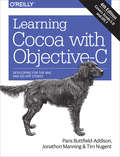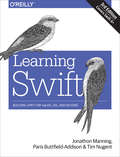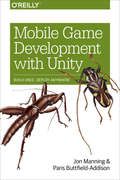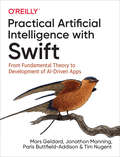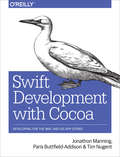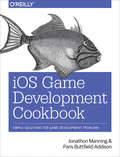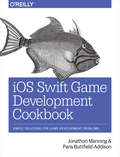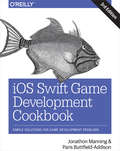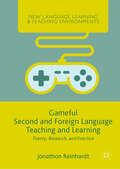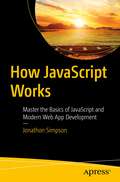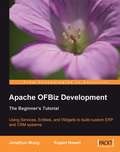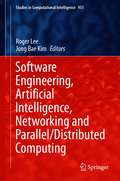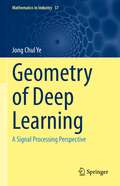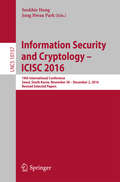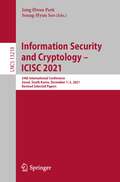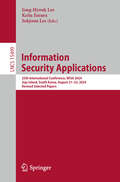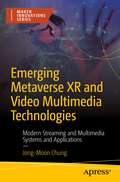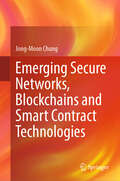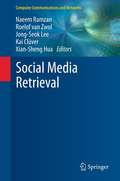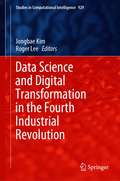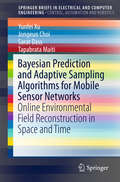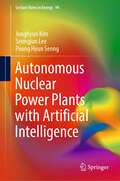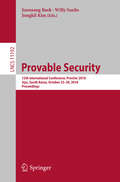- Table View
- List View
Learning Cocoa with Objective-C: Developing for the Mac and iOS App Stores
by Paris Buttfield-Addison Jonathon Manning Tim NugentGet up to speed on Cocoa and Objective-C, and start developing applications on the iOS and OS X platforms. If you don’t have experience with Apple’s developer tools, no problem! From object-oriented programming to storing app data in iCloud, the fourth edition of this book covers everything you need to build apps for the iPhone, iPad, and Mac.You’ll learn how to work with the Xcode IDE, Objective-C’s Foundation library, and other developer tools such as Event Kit framework and Core Animation. Along the way, you’ll build example projects, including a simple Objective-C application, a custom view, a simple video player application, and an app that displays calendar events for the user.Learn the application lifecycle on OS X and iOSWork with the user-interface system in Cocoa and Cocoa TouchUse AV Foundation to display video and audioBuild apps that let users create, edit, and work with documentsStore data locally with the file system, or on the network with iCloudDisplay lists or collections of data with table views and collection viewsInteract with the outside world with Core Location and Core MotionUse blocks and operation queues for multiprocessing
Learning Swift: Building Apps for macOS, iOS, and Beyond
by Paris Buttfield-Addison Jonathon Manning Tim NugentGet valuable hands-on experience with Swift, the open source programming language developed by Apple. With this practical guide, skilled programmers with little or no knowledge of Apple development will learn how to code with the latest version of Swift by developing a working iOS app from start to finish.You’ll begin with Swift programming basics—including guidelines for making your code "Swifty"—and learn how to work with Xcode and its built-in Interface Builder. Then you’ll dive step-by-step into building and customizing a basic app for taking, editing, and deleting selfies. You’ll also tune and test the app for performance and manage the app’s presence in the App Store.Divided into four parts, this book includes:Swift 4 basics: Learn Swift’s basic building blocks and the features of object-oriented developmentBuilding the Selfiegram app: Build model objects and the UI for your selfie app and add location support, user settings, and notificationsPolishing Selfiegram: Create a theme and support for sharing and add custom views, image overlays, and localizationBeyond app development: Debug and performance test with Xcode, automate chores with Fastlane, and user-test the app with TestFlight
Mobile Game Development with Unity: Build Once, Deploy Anywhere
by Paris Buttfield-Addison Jonathon ManningDo you want to build mobile games, but lack game development experience? No problem. This practical guide shows you how to create beautiful, interactive content for iOS and Android devices with the Unity game engine.Authors Jon Manning and Paris Buttfield-Addison (iOS Swift Game Development Cookbook) provide a top-to-bottom overview of Unity’s features with specific, project-oriented guidance on how to use them in real game situations. Over the course of this book, you’ll learn hands-on how to build 2D and 3D games from scratch that will hook and delight players. If you have basic programming skills, you’re ready to get started.Explore the basics of Unity, and learn how to structure games, graphics, scripting, sounds, physics, and particle systemsUse 2D graphics and physics features to build a side-scrolling action gameCreate a 3D space combat simulator with projectile shooting and respawning objects, and learn how to manage the appearance of 3D modelsDive into Unity’s advanced features, such as precomputed lighting, shading, customizing the editor, and deployment
Practical Artificial Intelligence with Swift: From Fundamental Theory to Development of AI-Driven Apps
by Paris Buttfield-Addison Jonathon Manning Tim Nugent Mars GeldardCreate and implement AI-based features in your Swift apps for iOS, macOS, tvOS, and watchOS. With this practical book, programmers and developers of all kinds will find a one-stop shop for AI and machine learning with Swift. Taking a task-based approach, you’ll learn how to build features that use powerful AI features to identify images, make predictions, generate content, recommend things, and more.AI is increasingly essential for every developer—and you don’t need to be a data scientist or mathematician to take advantage of it in your apps. Explore Swift-based AI and ML techniques for building applications. Learn where and how AI-driven features make sense. Inspect tools such as Apple’s Python-powered Turi Create and Google’s Swift for TensorFlow to train and build models.I: Fundamentals and Tools—Learn AI basics, our task-based approach, and discover how to build or find a dataset.II: Task Based AI—Build vision, audio, text, motion, and augmentation-related features; learn how to convert preexisting models.III: Beyond—Discover the theory behind task-based practice, explore AI and ML methods, and learn how you can build it all from scratch... if you want to
Swift Development with Cocoa: Developing for the Mac and iOS App Stores
by Paris Buttfield-Addison Jonathon Manning Tim NugentReady to build apps for iPhone, iPad, and Mac now that Swift has landed? If you’re an experienced programmer who’s never touched Apple developer tools, this hands-on book shows you how to use the Swift language to make incredible iOS and OS X apps, using Cocoa and Cocoa Touch.Learn how to use Swift in a wide range of real-world situations, with Cocoa features such as Event Kit and Core Animation. You’ll pick up Swift language features and syntax along the way, and understand why using Swift (instead of Objective-C) makes iOS and Mac app development easier, faster, and safer. You’ll also work with several exercises to help you practice as you learn.Learn the OS X and iOS application lifecycleUse storyboards to design adaptive interfacesExplore graphics systems, including the built-in 2D and 3D game frameworksDisplay video and audio with AVFoundationStore data locally with the file system, or on the network with iCloudDisplay lists or collections of data with table views and collection viewsBuild apps that let users create, edit, and work with documentsUse MapKit, Core Location, and Core Motion to interact with the world
iOS Game Development Cookbook
by Paris Buttfield-Addison Jonathon ManningWant to build games with iOS technologies? This cookbook provides detailed recipes for a wide range of common iOS game-development issues, ranging from 2D and 3D math to Game Center integration, and OpenGL to performance. If you’re familiar with iOS and Objective-C, this is the problem-solving guide you want.Rather than focus on specific game engines for iOS, such as Cocos2D or the Corona SDK, the recipes in this cookbook strictly deal with baked-in iOS technologies. You’ll learn solutions for everything from tile-matching games to racing, with working code that you can use right away.Lay out the structure of your gameBuild and customize menus with UIKitDetect and respond to user inputUse advanced techniques to play sound effects and musicWork with data, using iOS devices and the cloudCreate 2D graphics with SpriteKitAdd physics simulation to your gameLearn beginning to advanced 3D graphicsCreate challenges with artificial intelligenceUse networking to add multiplayer capabilitiesWork with game controllers and multiple screens
iOS Swift Game Development Cookbook
by Paris Buttfield-Addison Jonathon ManningReady to make amazing games for the iPhone, iPad, and iPod touch? With Apple's Swift programming language, it's never been easier. This updated cookbook provides detailed recipes for a managing wide range of common iOS game-development issues, ranging from 2D and 3D math to SpriteKit and OpenGL to performance--all revised for Swift.You get simple, direct solutions to common problems found in iOS game programming. Need to figure out how to give objects physical motion, or want a refresher on gaming-related math problems? This book provides sample projects and straightforward answers. All you need to get started is some familiarity with iOS development, Swift, and Objective-C.Design the architecture and code layout of your gameBuild and customize menus with UIKitDetect and respond to user inputUse techniques to play sound effects and musicLearn different ways to store information for later useCreate 2D graphics with SpriteKitCreate 3D graphics with SceneKitAdd two-dimensional physics simulationLearn beginning, intermediate, and advanced 3D graphics with OpenGLCreate challenges with artificial intelligenceTake advantage of game controllers and external displays
iOS Swift Game Development Cookbook: Simple Solutions for Game Development Problems
by Paris Buttfield-Addison Jonathon ManningReady to make amazing games for the iPhone and iPad? With Apple’s Swift programming language, it’s never been easier. This updated cookbook provides detailed recipes for managing a wide range of common iOS game-development issues, ranging from 2D and 3D math, SpriteKit, and OpenGL to augmented reality with ARKit.You get simple, direct solutions to common problems found in iOS game programming. Need to figure out how to give objects physical motion, or want a refresher on gaming-related math problems? This book provides sample projects and straightforward answers. All you need to get started is some familiarity with iOS development in Swift.
Gameful Second and Foreign Language Teaching and Learning: Theory, Research, and Practice (New Language Learning and Teaching Environments)
by Jonathon ReinhardtThis book offers a comprehensive examination of the theory, research, and practice of the use of digital games in second and foreign language teaching and learning (L2TL). It explores how to harness the enthusiasm, engagement, and motivation that digital gaming can inspire by adopting a gameful L2TL approach that encompasses game-enhanced, game-informed, and game-based practice. The first part of the book situates gameful L2TL in the global practices of informal learnful L2 gaming and in the theories of play and games which are then applied throughout the discussion of gameful L2TL practice that follows. This includes analysis of practices of digital game-enhanced L2TL design (the use of vernacular, commercial games), game-informed L2TL design (gamification and the general application of gameful principles to L2 pedagogy), and game-based L2TL design (the creation of digital games purposed for L2 learning). Designed as a guide for researchers and teachers, the book also offers fresh insights for scholars of applied linguistics, second language acquisition, L2 pedagogy, computer-assisted language learning (CALL), game studies, and game design that will open pathways to future developments in the field.
How JavaScript Works: Master the Basics of JavaScript and Modern Web App Development
by Jonathon SimpsonJavaScript is a complicated language with a lot of misinformation surrounding how it works. This book provides a comprehensive introduction to JavaScript, from how it works at a technical level to how it is used to create websites and applications. Everything you need to know to start a career in JavaScript development is covered here. How JavaScript Works begins with a practical introduction of the basics before moving into the technical underpinnings of JavaScript, detailing everything you need to know, including variables, memory storage, functions, classes, types, maps, sets and APIs. Once you’ve fully absorbed these key topics. author Jonathan Simpson will show you how to put them into practice, demonstrating how they are employed for modern web development. You’ll learn how to use JavaScript with HTML and CSS to construct web pages and applications, how to change CSS with JavaScript, and how to utilize Fetch and asynchronous operations. Upon completing this book, you will have the foundational knowledge necessary to continue your journey to becoming a professional JavaScript developer. What You Will Learn: Gain insight into the technical essentials of JavaScript and how it worksLearn advanced concepts and such as memory storage and how classes, functions and objects actually workExplore the basic mathematical underpinnings of JavaScriptUnderstand how JavaScript is used to manipulate HTML and CSSObtain the tools and knowledge needed to start your career in web development Who This Book Is For: Anyone interested in a web development career, as well as those who may have already embarked on their careers, but who want to deepen their technical understanding of JavaScript and how it works.
Apache OFBiz Development: The Beginner's Tutorial
by Jonathon Wong Rupert HowellThis is an accessible step-by-step tutorial that introduces readers to the world of OFBiz through practical examples and clear explanations. It will guide you through the framework, teach you to tweak OFBiz and master widgets, entities, and permissions, and give you the knowledge to customize your own bespoke applications. This book is for developers who want to build easily deployed and supported OFBiz applications. No previous knowledge of OFBiz is assumed, but readers should be comfortable in a Java development environment.
Software Engineering, Artificial Intelligence, Networking and Parallel/Distributed Computing (Studies in Computational Intelligence #951)
by Roger Lee Jong Bae KimThis edited book presents scientific results of the 21st ACIS International Winter Conference on Software Engineering, Artificial Intelligence, Networking and Parallel/Distributed Computing (SNPD2021-Winter) which was held on January 28–30, at Ho Chi Minh City, Vietnam. The aim of this conference was to bring together researchers and scientists, businessmen and entrepreneurs, teachers, engineers, computer users, and students to discuss the numerous fields of computer science and to share their experiences and exchange new ideas and information in a meaningful way and research results about all aspects (theory, applications, and tools) of computer and information science, and to discuss the practical challenges encountered along the way and the solutions adopted to solve them.The conference organizers selected the best papers from those papers accepted for presentation at the conference. The papers were chosen based on review scores submitted by members of the program committee and underwent further rigorous rounds of review. From this second round of review, 18 of most promising papers are then published in this Springer (SCI) book and not the conference proceedings. We impatiently await the important contributions that we know these authors will bring to the field of computer and information science.
Geometry of Deep Learning: A Signal Processing Perspective (Mathematics in Industry #37)
by Jong Chul YeThe focus of this book is on providing students with insights into geometry that can help them understand deep learning from a unified perspective. Rather than describing deep learning as an implementation technique, as is usually the case in many existing deep learning books, here, deep learning is explained as an ultimate form of signal processing techniques that can be imagined. To support this claim, an overview of classical kernel machine learning approaches is presented, and their advantages and limitations are explained. Following a detailed explanation of the basic building blocks of deep neural networks from a biological and algorithmic point of view, the latest tools such as attention, normalization, Transformer, BERT, GPT-3, and others are described. Here, too, the focus is on the fact that in these heuristic approaches, there is an important, beautiful geometric structure behind the intuition that enables a systematic understanding. A unified geometric analysis to understand the working mechanism of deep learning from high-dimensional geometry is offered. Then, different forms of generative models like GAN, VAE, normalizing flows, optimal transport, and so on are described from a unified geometric perspective, showing that they actually come from statistical distance-minimization problems.Because this book contains up-to-date information from both a practical and theoretical point of view, it can be used as an advanced deep learning textbook in universities or as a reference source for researchers interested in acquiring the latest deep learning algorithms and their underlying principles. In addition, the book has been prepared for a codeshare course for both engineering and mathematics students, thus much of the content is interdisciplinary and will appeal to students from both disciplines.
Information Security and Cryptology – ICISC 2016
by Seokhie Hong Jong Hwan ParkThis book constitutes revised selected papers from the 19th International Conference on Information Security and Cryptology, ICISC 2016, held in Seoul, South Korea, in November/December 2016. The 18 full papers presented in this volume were carefully reviewed and selected from 69 submissions. There were organized in topical sections named: protocols; lattice cryptography; encryption; implementation and algorithms; signatures and protocol; and analysis.
Information Security and Cryptology – ICISC 2021: 24th International Conference, Seoul, South Korea, December 1–3, 2021, Revised Selected Papers (Lecture Notes in Computer Science #13218)
by Jong Hwan Park Seung-Hyun SeoThis book constitutes selected papers from the 24th International Conference on Information Security and Cryptology, ICISC 2021, held in Seoul, South Korea, in December 2021. The total of 23 papers presented in this volume were carefully reviewed and selected from 63 submissions. The papers are arranged by topic: Cryptographic Protocol in Quantum Computer Age; Security Analysis of Hash Algorithm; Security analysis of Symmetric Key Encryption Algorithm; Fault and Side-Channel Attack; Constructions and Designs; Quantum Circuit; Efficient Implementation. The aim of this conference was to provide an international forum for the latest results of research, development, and applications within the field of information security and cryptology.
Information Security Applications: 25th International Conference, WISA 2024, Jeju Island, South Korea, August 21–23, 2024, Revised Selected Papers (Lecture Notes in Computer Science #15499)
by Jong-Hyouk Lee Keita Emura Sokjoon LeeThis book constitutes the refereed proceedings of the 25th International Conference on Information Security Applications, WISA 2024, held in Jeju Island, South Korea, during August 21–23, 2024. The 28 full papers included in this book were carefully reviewed and selected from 87 submissions. They were organized in topical sections as follows: Cryptography; Network Security; AI Security 1; Network & Application Security; AI Security 2; CPS Security; Fuzzing; Malware; Software Security; and Emerging Topic.
Emerging Metaverse XR and Video Multimedia Technologies: Modern Streaming and Multimedia Systems and Applications
by Jong-Moon ChungImprove the video multimedia services you work on or develop using tools from video service technologies such as Netflix, Disney+, YouTube, and Skype. This book introduces you to the core technologies that enable Metaverse XR (eXtended Reality) services and advanced video multimedia streaming services.First, you’ll find out about the current and future trends in Metaverse and video streaming services. XR is a combination of technologies that include MR, AR, VR, voice recognition systems, haptic and 3D-motion UIs, as well as head mounted displays) like Microsoft Hololens 2 and Oculus Quest 2. You'll review metaverse services XR applications and learn more about the core XR feature extraction technologies. With XR capabilities mastered, you can move into the main technologies for video streaming services like Netflix, Disney+, and YouTube. You’ll also about video formats, such as H.264, MPEG-4 AVC, H.265, MPEG-5, and MPEG-DASH. As well as online hosting services like content delivery network (CDN), mobile CDN, and Amazon Web Services (AWS). Additional details on content aging and updating operations along with CDN popularity predictions and contents update techniques, such as, Least Recently Used (LRU) and east Frequently Used (LFU) strategies are introduced. All these technologies enable fast, efficient, reliable, and adaptable video streaming services. They also allow for video conferencing services like Zoom, Skype and WebEx. By the time you’ve finished reading, you’ll understand how these technologies converge into the Metaverse and and offer a wide variety of development opportunities for video streaming. What You'll LearnIncorporate core AI techniques and extraction XR algorithmsEnable fast, efficient, and reliable video streaming in your product, service, or appUpdate content with CDN popularity predictionsExplore the Netflix Open Connect CDN model and characteristics Understand the operations of modern video and multimedia systemsBecome a leader in metaverse and video multimedia services and products.Who This Book Is ForDevelopers, product managers, hobbyists, and students interested in learning how Metaverse XR and video streaming work and can be developed.
Emerging Secure Networks, Blockchains and Smart Contract Technologies
by Jong-Moon ChungThis book equips readers with the essential knowledge to innovate and improve network performance while ensuring security and safety. It covers foundational TCP/IP Internet network technologies and significant cyber-attack case studies. Additionally, it explains the core technologies behind Bitcoin, Ethereum, blockchains, smart contracts, hash functions, and encryption. The book also explores advanced concepts such as reinforcement learning, generative AI, federated learning, and digital twin technologies, offering new approaches to enhancing network security and blockchains through these cutting-edge methods.
Social Media Retrieval
by Jong-Seok Lee Kai Clüver Roelof Van Zwol Xian-Sheng Hua Naeem RamzanThis comprehensive text/reference examines in depth the synergy between multimedia content analysis, personalization, and next-generation networking. The book demonstrates how this integration can result in robust, personalized services that provide users with an improved multimedia-centric quality of experience. Each chapter offers a practical step-by-step walkthrough for a variety of concepts, components and technologies relating to the development of applications and services. Topics and features: introduces the fundamentals of social media retrieval, presenting the most important areas of research in this domain; examines the important topic of multimedia tagging in social environments, including geo-tagging; discusses issues of personalization and privacy in social media; reviews advances in encoding, compression and network architectures for the exchange of social media information; describes a range of applications related to social media.
Data Science and Digital Transformation in the Fourth Industrial Revolution (Studies in Computational Intelligence #929)
by Roger Lee Jongbae KimThis edited book presents scientific results of the International Semi-Virtual Workshop on Data Science and Digital Transformation in the Fourth Industrial Revolution (DSDT 2020) which was held on October 15, 2020, at Soongsil University, Seoul, Korea. The aim of this workshop was to bring together researchers and scientists, businessmen and entrepreneurs, teachers, engineers, computer users, and students to discuss the numerous fields of computer science and to share their experiences and exchange new ideas and information in a meaningful way. Research results about all aspects (theory, applications and tools) of computer and information science, and to discuss the practical challenges encountered along the way and the solutions adopted to solve them. The workshop organizers selected the best papers from those papers accepted for presentation at the workshop. The papers were chosen based on review scores submitted by members of the program committee and underwent further rigorous rounds of review. From this second round of review, 17 of the conference’s most promising papers are then published in this Springer (SCI) book and not the conference proceedings. We impatiently await the important contributions that we know these authors will bring to the field of computer and information science.
Bayesian Prediction and Adaptive Sampling Algorithms for Mobile Sensor Networks: Online Environmental Field Reconstruction in Space and Time (SpringerBriefs in Electrical and Computer Engineering)
by Jongeun Choi Yunfei Xu Sarat Dass Tapabrata MaitiThis brief introduces a class of problems and models for the prediction of the scalar field of interest from noisy observations collected by mobile sensor networks. It also introduces the problem of optimal coordination of robotic sensors to maximize the prediction quality subject to communication and mobility constraints either in a centralized or distributed manner. To solve such problems, fully Bayesian approaches are adopted, allowing various sources of uncertainties to be integrated into an inferential framework effectively capturing all aspects of variability involved. The fully Bayesian approach also allows the most appropriate values for additional model parameters to be selected automatically by data, and the optimal inference and prediction for the underlying scalar field to be achieved. In particular, spatio-temporal Gaussian process regression is formulated for robotic sensors to fuse multifactorial effects of observations, measurement noise, and prior distributions for obtaining the predictive distribution of a scalar environmental field of interest. New techniques are introduced to avoid computationally prohibitive Markov chain Monte Carlo methods for resource-constrained mobile sensors. Bayesian Prediction and Adaptive Sampling Algorithms for Mobile Sensor Networks starts with a simple spatio-temporal model and increases the level of model flexibility and uncertainty step by step, simultaneously solving increasingly complicated problems and coping with increasing complexity, until it ends with fully Bayesian approaches that take into account a broad spectrum of uncertainties in observations, model parameters, and constraints in mobile sensor networks. The book is timely, being very useful for many researchers in control, robotics, computer science and statistics trying to tackle a variety of tasks such as environmental monitoring and adaptive sampling, surveillance, exploration, and plume tracking which are of increasing currency. Problems are solved creatively by seamless combination of theories and concepts from Bayesian statistics, mobile sensor networks, optimal experiment design, and distributed computation.
Autonomous Nuclear Power Plants with Artificial Intelligence (Lecture Notes in Energy #94)
by Poong Hyun Seong Jonghyun Kim Seungjun LeeThis book introduces novel approaches and practical examples of autonomous nuclear power plants that minimize operator intervention. Autonomous nuclear power plants with artificial intelligence presents a framework to enable nuclear power plants to autonomously operate and introduces artificial intelligence (AI) techniques to implement its functions. Although nuclear power plants are already highly automated to reduce human errors and guarantee the reliability of system operations, the term “autonomous” is still not popular because AI techniques are regarded as less proven technologies. However, the use of AI techniques and the autonomous operation seems unavoidable because of their great advantages, especially, in advanced reactors and small modular reactors.The book includes the following topics:Monitoring, diagnosis, and prediction.Intelligent control.Operator support systems.Operator-autonomous system interaction.Integration into the autonomous operation system. This book will provides useful information for researchers and students who are interested in applying AI techniques in the fields of nuclear as well as other industries. This book covers broad practical applications of AI techniques from the classical fault diagnosis to more recent autonomous control. In addition, specific techniques and modelling examples are expected to be very informative to the beginners in the AI studies.
Provable Security: 12th International Conference, ProvSec 2018, Jeju, South Korea, October 25-28, 2018, Proceedings (Lecture Notes in Computer Science #11192)
by Willy Susilo Joonsang Baek Jongkil KimThis book constitutes the refereed proceedings of the 12th International Conference on Provable Security, ProvSec 2018, held in Jeju, South Korea, in October 2018. The 21 full and 4 short papers presented were carefully reviewed and selected from 48 submissions. The papers are grouped in topical sections on foundation. Public key encryption, digital signature, symmetric key cryptography, and applications.
Information Security and Cryptology - ICISC 2014
by Jooyoung Lee Jongsung KimThis book constitutes the thoroughly refereed post-conference proceedings of the 17th International Conference on Information Security and Cryptology, ICISC 2014, held in Seoul, South Korea in December 2014. The 27 revised full papers presented were carefully selected from 91 submissions during two rounds of reviewing. The papers provide the latest results in research, development and applications in the field of information security and cryptology. They are organized in topical sections on RSA security, digital signature, public key cryptography, block ciphers, network security, mobile security, hash functions, information hiding and efficiency, cryptographic protocol, and side-channel attacks.
War Games (Quick Takes: Movies and Popular Culture)
by Jonna EagleThe word “wargames” might seem like a contradiction in terms. After all, the declaration “This is war” is meant to signal that things have turned deadly serious, that there is no more playing around. Yet the practices of war are intimately entangled with practices of gaming, from military videogames to live battle reenactments. How do these forms of play impact how both soldiers and civilians perceive acts of war? This Quick Take considers how various war games and simulations shape the ways we imagine war. Paradoxically, these games grant us a sense of mastery and control as we strategize and scrutinize the enemy, yet also allow us the thrilling sense of being immersed in the carnage and chaos of battle. But as simulations of war become more integrated into both popular culture and military practice, how do they shape our apprehension of the traumatic realities of warfare? Covering everything from chess to football, from Saving Private Ryan to American Sniper, and from Call of Duty to drone interfaces, War Games is an essential guide for anyone seeking to understand the militarization of American culture, offering a compact yet comprehensive look at how we play with images of war.
